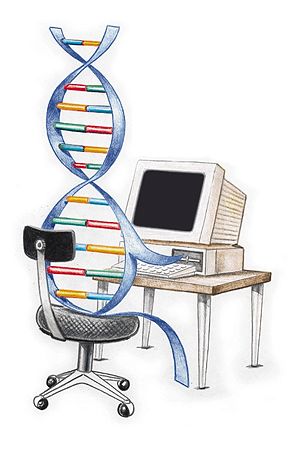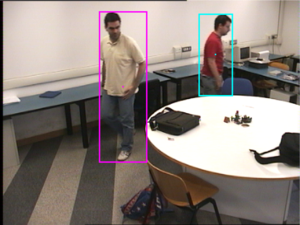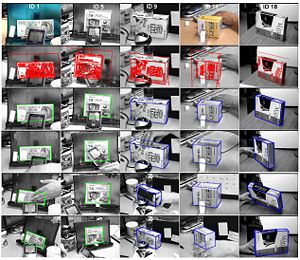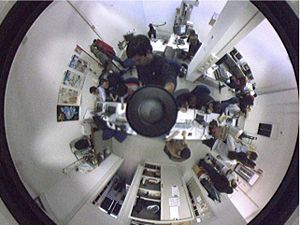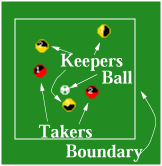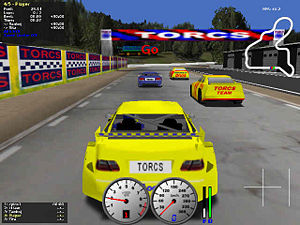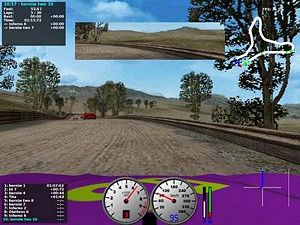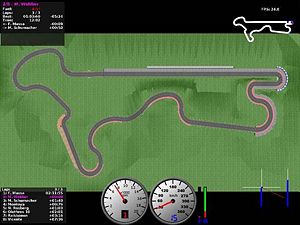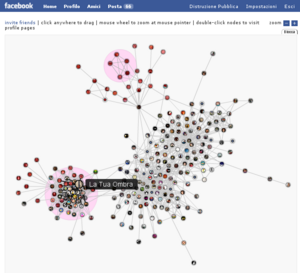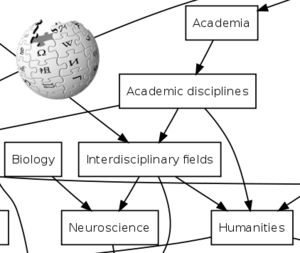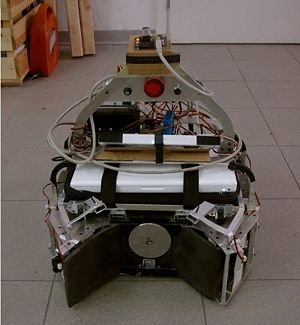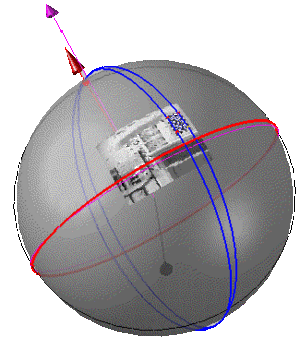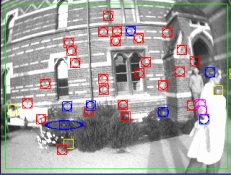Difference between revisions of "Master Level Course Projects"
DavidLaniado (Talk | contribs) m (→Social Software and Semantic Web) |
DavidLaniado (Talk | contribs) m (→Social Software and Semantic Web) |
||
| Line 340: | Line 340: | ||
==== Social Software and Semantic Web ==== | ==== Social Software and Semantic Web ==== | ||
| − | + | ||
| − | + | ||
{{#ask: [[Category:ProjectProposal]] | {{#ask: [[Category:ProjectProposal]] | ||
[[PrjResArea::Social Software and Semantic Web]] | | [[PrjResArea::Social Software and Semantic Web]] | | ||
Revision as of 15:49, 17 July 2009
Here you can find a list of project proposals for the courses of "Laboratorio di Intelligenza Artificiale e Robotica" (5 CFU for each student) and "Soft Computing" (1 CFU for each student). See Project Proposals for other kinds of projects and theses.
Contents
Evolutionary Optimization and Stochastic Optimization
| Title: | Combinatorial optimization based on stochastic relaxation | |
|---|---|---|
| Description: | The project will focus on the study, implementation, comparison and analysis of different algorithms for the optimization of pseudo-Boolean functions, i.e., functions defined over binary variables with values in R. These functions have been studied a lot in the mathematical programming literature, and different algorithms have been proposed [1]. More recently, the same problems have been faced in evolutionary computations, with the use of genetic algorithms, and in particular estimation of distribution algorithms [2,3]. Estimation of distribution algorithms are a recent meta-heuristic, where classical crossover and mutation operators used in genetic algorithms are replaced with operators that come from statistics, such as sampling and estimation.
The focus will be on the implementation of existing algorithms able to combine different approaches (estimation and sampling, from one side, and exploitation of prior knowledge about the structure of problem, on the other), together with the comparison of the results with existing techniques that historically appear in different (and often separated) communities. Good coding (C/C++) abilities are required. Since the approach will be based on statistical models, the student is supposed to be comfortable with notions that come from probability and statistics courses. Picture taken from http://www.ra.cs.uni-tuebingen.de/
| |
| Tutor: | Matteo Matteucci ([1]), Luigi Malagò (email) | |
| Start: | Anytime | |
| Number of students: | 1-2 | |
| CFU: | 20-40 |
Evolutionary Computation
| Title: | Combining Estimation of Distribution Algorithms and other Evolutionary techniques for combinatorial optimization | |
|---|---|---|
| Description: | The project will focus on the study, implementation, comparison and analysis of different algorithms for combinatorial optimization using techniques and algorithms proposed in Evolutionary Computation. In particular we are interested in the study of Estimation of Distribution Algorithms [1,2,3,4], a recent meta-heuristic, often presented as an evolution of Genetic Algorithms, where classical crossover and mutation operators, used in genetic algorithms, are replaced with operators that come from statistics, such as sampling and estimation.
The focus will be on the implementation of new hybrid algorithms able to combine estimation of distribution algorithms with different approaches available in the evolutionary computation literature, such as genetic algorithms and evolutionary strategies, together with other local search techniques. Good coding (C/C++) abilities are required. Some background in combinatorial optimization form the "Fondamenti di Ricerca Operativa" is desirable. The project could require some effort in order to build and consolidate some background in MCMC techniques, such as Gibbs and Metropolis samplers [4]. The project could be extended to master thesis, according to interesting and novel directions of research that will emerge in the first part of the work. Picture taken from http://www.genetic-programming.org
| |
| Tutor: | Matteo Matteucci ([2]), Luigi Malagò (email) | |
| Start: | Anytime | |
| Number of students: | 1-2 | |
| CFU: | 5-10 |
Sleep Staging
| Title: | Development of a computer-assisted CAP (Sleep cyclic alternating pattern) scoring method | |
|---|---|---|
| Description: | In 1985, Terzano describes for the first time the Cyclic Alternating Pattern [3] during sleep and, nowadays, CAP is widely accepted by the medical community as basic analysis of sleep. The CAP evaluation is of fundamental importance since it represents the mechanism developed by the brain evolution to monitor the inner and outer world and to assure the survival during sleep. However, visual detection of CAP in polisomnography (i.e., the standard procedure) is a slow and time-consuming process. This limiting factor generates the necessity of new computer-assisted scoring methods for fast CAP evaluation. This thesis deals with the development of a Decision Support System for CAP scoring based on features extraction at multi-system level (by statistical and signal analysis) and Pattern Recognition or Machine Learning approaches. This may allow the automatic detection of CAP sleep and could be integrated, through reinforcement learning techniques, with the corrections given by physicians.
| |
| Tutor: | Matteo Matteucci (email), Martin Mendez (email), Anna Maria Bianchi (email), Mario Terzano (Ospedale di Parma) | |
| Start: | Anytime | |
| Number of students: | 1-2 | |
| CFU: | 5-20 |
BioSignal Analysis
| Title: | Human-computer interaction via voice recognition system | |
|---|---|---|
| Description: | We want develop a system to allow a voice interaction between the user and the wheelchair.
This project consists in develop one of the solutions proposed in literature and extended the LURCH software to include this kind of interface.
References:
| |
| Tutor: | Matteo Matteucci (email), Davide Migliore (email) | |
| Start: | Anytime | |
| Number of students: | 1-2 | |
| CFU: | 2.5-10 |
Brain-Computer Interface
| Title: | Driving an autonomous wheelchair with a P300-based BCI | |
|---|---|---|
| Description: | This project pulls together different Airlab projects with the aim to drive an autonomous wheelchair (LURCH) with a BCI, through the development of key software modules. Depending on the effort the student is willing to put into it, the project can grow to a full experimental thesis.
| |
| Tutor: | Matteo Matteucci (email), Bernardo Dal Seno (email) | |
| Start: | November 2008 | |
| Number of students: | 1 | |
| CFU: | 5-20 |
| Title: | Reproduction of an algorithm for the recognition of error potentials | |
|---|---|---|
| Description: | Error potentials (ErrPs) are event-related potentials present in the EEG (electroencephalogram) when a subject makes a mistake or when the machine a subject is interacting with works in an expected way. They could be used in the BCI field to improve the performance of a BCI by automatically detecting classification errors.
The project aims at reproducing algorithms for ErrP detection from the literature.
| |
| Tutor: | Matteo Matteucci (email), Bernardo Dal Seno (email) | |
| Start: | This project has already been assigned | |
| Number of students: | 1 | |
| CFU: | 5-15 |
Computer Vision and Image Analysis
| Title: | Environment Monitoring | |
|---|---|---|
| Description: | The goal of this project is to develop a video surveillance system to track in 3D vehicles or people.
The idea is to use one or more calibrated camera to estimate the position and the trajectories of the moving objects in the scene. The skills required for this project are:
The project can be turned into a thesis extending the algorithm for a generic outdoor environment. | |
| Tutor: | Matteo Matteucci (email), Davide Migliore (email) | |
| Start: | Anytime | |
| Number of students: | 2-3 | |
| CFU: | 10-15 |
| Title: | Visual Merchandising | |
|---|---|---|
| Description: | The goal of this project is to develop algorithms to count the number of products on the shelves of a market.
The idea is to use a calibrated camera to recognize the shelves, estimate the scale and improve the image quality. The skills required for this project are:
| |
| Tutor: | Matteo Matteucci (email), Davide Migliore (email) | |
| Start: | As soon as possible | |
| Number of students: | 2-3 | |
| CFU: | 2.5-15 |
| Title: | Analysis of patch recognition algorithms | |
|---|---|---|
| Description: | Extract distinctive features from images is very important in computer vision application.
It can be used in algorithms for tasks like matching different views of an object or scene (e.g. for stereo vision) and object recognition. The aim of this work is to integrate in an existent framework the existing solution proposed in literature. Skills
References: | |
| Tutor: | Matteo Matteucci (email), Davide Migliore (email) | |
| Start: | Anytime | |
| Number of students: | 2-3 | |
| CFU: | 2.5-15 |
| Title: | Catadioptric MonoSLAM | |
|---|---|---|
| Description: | The goal of this work is to investigate a SLAM solutions based on catadioptric camera, integrating the solution presented in literature into an existing frameword.
Improvements could be the basis for a tesi. Skills
References: | |
| Tutor: | Matteo Matteucci (email), Davide Migliore (email) | |
| Start: | Anytime | |
| Number of students: | 2-3 | |
| CFU: | 2.5-15 |
| Title: | Trinocular Vision System (SUGR) | |
|---|---|---|
| Description: | A Trinocular Vision System is a device composed by three cameras that allows to measure 3D data (in this case segments) directly from images.
The aim of this tesina/project is to implement a trinocular algorithm based on SUGR, a library for Uncertain Projective Geometry. Skills
| |
| Tutor: | Matteo Matteucci (email), Davide Migliore (email) | |
| Start: | As soon as possible | |
| Number of students: | 2-3 | |
| CFU: | 2.5-15 |
| Title: | GIFT and features extraction and description | |
|---|---|---|
| Description: | The idea is to improve and optimize the solution proposed by Campari et al. in their paper, who propose to estimate invariant descriptor using geodesic features descriptor based on color information.
Skills
| |
| Tutor: | Matteo Matteucci (email), Davide Migliore (email) | |
| Start: | Anytime | |
| Number of students: | 1-3 | |
| CFU: | 10-20 |
| Title: | Multimedia Indexing Framework | |
|---|---|---|
| Description: | The goal of this project is to develop a framework for multimedia indexing.
The idea is create an images database indexer that allows to make query using images or strings. Skills
References: | |
| Tutor: | Matteo Matteucci (email), Davide Migliore (email) | |
| Start: | Anytime | |
| Number of students: | 1-3 | |
| CFU: | 2.5-15 |
Machine Learning
| Title: | Statistical inference for phylogenetic trees | |
|---|---|---|
| Description: | The project will focus on the study, implementation, comparison and analysis of different statistical inference techniques for phylogenetic trees. Phylogenetic trees [1, 2, 3] are evolutionary trees used to represent the relationships between different species with a common ancestor. Typical inference task concern the construction of a tree starting from DNA sequences, involving both the choice of the topology of the tree (i.e., model selection) and the values of the parameters (i.e., model fitting). The focus will be a probabilistic description of the tree, given by the introduction of stochastic variables associated to both internal nodes and leaves of the tree.
The project will focus on the understanding of the problem and on the implementation of different algorithms, so (C/C++ or Matlab or R) coding will be required. Since the approach will be based on statistical models, the student is supposed to be comfortable with notions that come from probability and statistics courses. Picture taken from http://www.tolweb.org/tree/
| |
| Tutor: | Matteo Matteucci ([16]), Luigi Malagò (email) | |
| Start: | Anytime | |
| Number of students: | 1-2 | |
| CFU: | 20-40 |
| Title: | Reinforcement Learning Competition | |
|---|---|---|
| Description: | This project has the goal of participating to (and possibly winning ;)) the 2009 Reinforcement Learning competition. To have an idea of what participate to such a competition means you can have a look at the website of the 2008 RL competition.
The problems that will be proposed are still unknown. As soon as the domains will be published, the work will start by analyzing their main characteristics and, then we will identify which RL algorithms are most suited for solving such problems. After an implementation phase, the project will required a long experimental period to tune the parameters of the learning algorithms in order to improve the performance as much as possible. | |
| Tutor: | Marcello Restelli (restelli-AT-elet-DOT-polimi-DOT-it) | |
| Start: | January, 2009 | |
| Number of students: | 2-4 | |
| CFU: | 10-20 |
| Title: | Learning API for TORCS | |
|---|---|---|
| Description: | TORCS is a state-of-the-art open source racing simulator that represents an ideal bechmark for machine learning techniques. We already organized two successfull competitions based on TORCS where competitors have been asked to develop a controller using their preferred machine learning techniques. The goal of this project is to extend the existing C++ API (available here) to simplify the development of controller using a learning framework.
Such an extension can be partially developed by porting an existing Java API for TORCS that already provides a lot of functionalities for machine learning approaches. | |
| Tutor: | Daniele Loiacono (loiacono-AT-elet-DOT-polimi-DOT-it) | |
| Start: | Anytime | |
| Number of students: | 1 to 2 | |
| CFU: | 5 to 12.5 |
| Title: | EyeBot | |
|---|---|---|
| Description: | TORCS is a state-of-the-art open source racing simulator that represents an ideal bechmark for machine learning techniques. We already organized two successfull competitions based on TORCS where competitors have been asked to develop a controller using their preferred machine learning techniques. So far, the controller developed for TORCS used as input only information extracted directly from the state of the game. The goal of this project is to extend the existing controller API (see here) to use the visual information (e.g. the screenshots of the game) as input to the controllers. A successfull project will include both the development of the API and some basic imaga preprocessing to extract information from the images. | |
| Tutor: | Daniele Loiacono (loiacono-AT-elet-DOT-polimi-DOT-it), Alessandro Giusti (giusti-AT-elet-DOT-polimi-DOT-it), and Pierluigi Taddei (taddei-AT-elet-DOT-polimi-DOT-it) | |
| Start: | Anytime | |
| Number of students: | 1 to 2 | |
| CFU: | 5 to 20 |
| Title: | SmarTrack | |
|---|---|---|
| Description: | The generation of customized game content for each player is an attractive direction to improve the game experience in the next-generation computer games. In this scenario, Machine Learning could play an important role to provide automatically such customized game content.
The goal of this project is to apply machine learning techniques for the generation of customized tracks in TORCS, a state-of-the-art open source racing simulator. The project include different activities: the automatic generation of tracks, the section of relevant features to characterize a track and the analysis of an interest measure. | |
| Tutor: | Daniele Loiacono (loiacono-AT-elet-DOT-polimi-DOT-it) | |
| Start: | Anytime | |
| Number of students: | 1 to 2 | |
| CFU: | 5 to 20 |
| Title: | TORCS competition | |
|---|---|---|
| Description: | TORCS is a state-of-the-art open source racing simulator that represents an ideal bechmark for machine learning techniques. We already organized two successfull competitions based on TORCS where competitors have been asked to develop a controller using their preferred machine learning techniques.
The goal of this project is to apply any machine learning technique to develop a successfull controller following the competition rules (available here) | |
| Tutor: | Daniele Loiacono (loiacono-AT-elet-DOT-polimi-DOT-it) | |
| Start: | Anytime | |
| Number of students: | 1 | |
| CFU: | 5 |
Social Software and Semantic Web
| Wiki Page: | A firefox extension for semantic annotations | |
| Title: | A Firefox extension for semantic annotations | |
| Description: | Aim of this project is to develop a Firefox extension, to allow a community of users to annotate resources on the Web using a shared RDF vocabulary.
While browsing the Web, a user should be able to visualize the annotations relative to the page they are visiting, and to add new annotations as well. | |
| Tutor: | [[DavidLaniado | ]] (, , , , , , , , , , , , , , , , , , … further resultswarning.png
| |
| Start: | ||
| Students: | 1 - 2 | |
| CFU: | 5 - 20 | |
| Research Area: | Social Software and Semantic Web | |
| Research Topic: | Semantic Annotations |
| Wiki Page: | Annotation aggregators from social applications | |
| Title: | Annotation aggregators from social applications | |
| Description: | Annotations are metadata published about a resource, such as tags in del.icio.us, comments on stumbleupon.com, or twines on Twine.com. One of the main problems of these annotations is that they are not expressed in a standard format: thus, any tool trying to aggregate information from these sources should be able to access each one of them in a different way.
The purpose of this project is to develop translation tools for different social annotation systems, collect their data in a common format (expressed using an ontology), and show them through a unique user interface, able to display different annotations (i.e. geo coordinates, dates, tags, etc.) in different ways. Moreover, tests and evaluations should be performed on this aggregator to show how efficient the queries are when performed on-the-fly or from an intermediate knowledge base. | |
| Tutor: | [[DavideEynard | ]] (, , , , , , , , , , , , , , , , , , … further resultswarning.png
| |
| Start: | ||
| Students: | 1 - 2 | |
| CFU: | 5 - 20 | |
| Research Area: | Social Software and Semantic Web | |
| Research Topic: | Semantic Annotations |
| Wiki Page: | Detecting patterns in ontology usage | |
| Title: | Detecting patterns in ontology usage | |
| Description: | When building a new knowledge base the reuse of existing, well known vocabularies is often desirable. However, sometimes it is not clear which ontology should be preferable or which term is best suited for a specific application. Aim of this project is to detect patterns in ontology usage by harvesting ontologies which use a given schema (i.e. Foaf or Dublin Core) and analysing how people are using them in practice. The resulting application should download ontologies from the main semantic search engines (such as http://watson.kmi.open.ac.uk/ and http://sindice.com/), parse them and calculate statistics about the terms used inside them. The tool should show these statistics, save them in an appropriate format and make them available through an API for use by external applications. | |
| Tutor: | [[DavideEynard | ]] (, , , , , , , , , , , , , , , , , , … further resultswarning.png
| |
| Start: | ||
| Students: | 1 - 2 | |
| CFU: | 5 - 20 | |
| Research Area: | Social Software and Semantic Web | |
| Research Topic: | Semantic Annotations |
| Wiki Page: | Extending a search engine with semantic information | |
| Title: | Extending a search engine with semantic information | |
| Description: | We are used to keyword-based search engines, where only documents matching the exact words in the query are retrieved. In a traditional search engine, if you submit the query "a dinosaur in a university in Lombardy" you won't probably find a document containing the phrase "a velociraptor in Politecnico di Milano", even though it's more or less what you were looking for.
Aim of this project is to expand a traditional search engine with semantic information, so that also documents containing words related to the ones in the query can be retrieved. Existing thesauri and ontologies can be used, as well as more dynamic and collaborative sources of knowledge such as user tags and wikipedia pages and categories. Starting points for this work can be the projects "SeQuEx - Semantic Query Expansion" and "Enriching search results with semantic metadata". | |
| Tutor: | [[DavidLaniado | ]] (, , , , , , , , , , , , , , , , , , … further resultswarning.png
| |
| Start: | ||
| Students: | 1 - 2 | |
| CFU: | 5 - 20 | |
| Research Area: | Social Software and Semantic Web | |
| Research Topic: | Semantic Search |
| Wiki Page: | Facebook automatic list suggestion | |
| Title: | Facebook Automatic List Suggestion | |
| Description: | In Facebook each user can create lists of friends (for example: "high school","university","tennis") to better filter information and manage privacy.
Goal of this project is to develop a Facebook application to analyze a user's network of friends and automatically detect groups to suggest lists. | |
| Tutor: | [[DavidLaniado | ]] (, , , , , , , , , , , , , , , , , , … further resultswarning.png
| |
| Start: | ||
| Students: | 1 - 2 | |
| CFU: | 5 - 10 | |
| Research Area: | Social Software and Semantic Web | |
| Research Topic: | Social Network Analysis |
| Wiki Page: | Mining wikipedia categories | |
| Title: | Wikipedia category map | |
| Description: | Wikipedia articles are organized in a hierarchy of categories, manually assigned by users. This process can be considered a huge effort for the collective categorization of human knowledge; the result is a wide and disordered graph which can provide precious information for a variety of applications (natural language processing, information retrieval, ontology building...).
In the project "Wikipedia Category Map" a tool has been developed to extract the graph of Wikipedia categories, to store it in RDF format and to interactively visualize and explore it. Aim of this project is to analyze the resulting graph for the extraction of semantic relationships; for example it is possible to define metrics of distance between topics in the graph, which can be useful for various purposes in information retrieval. | |
| Tutor: | [[DavidLaniado | ]] (, , , , , , , , , , , , , , , , , , … further resultswarning.png
| |
| Start: | 7 July 2009 | |
| Students: | 1 - 2 | |
| CFU: | 5 - 20 | |
| Research Area: | Social Software and Semantic Web | |
| Research Topic: | Semantic Tagging |
| Wiki Page: | Social Network Data Extraction from Online Communities | |
| Title: | Social Network Data Extraction From Online Communities | |
| Description: | With the growth of the Web and the emergence of online communities, a huge amount of data regarding social relationships is now available, that was unthinkable until a few years ago. The network of connections may unveil precious information about communities structures and dynamics and the spreading of information in the Web.
Aim of this project is to design and develop a software tool to extract this kind of information from a single social network platform (decided by the student). It may be required also some kind of analysis or visual representation of the collected data. | |
| Tutor: | [[DavidLaniado | ]] (, , , , , , , , , , , , , , , , , , … further resultswarning.png
| |
| Start: | ||
| Students: | 1 - 2 | |
| CFU: | 5 - 20 | |
| Research Area: | Social Software and Semantic Web | |
| Research Topic: | Social Network Analysis |
| Wiki Page: | Use case design and implementation for semantic annotations | |
| Title: | Use case design and implementation for semantic annotation | |
| Description: | Semantic annotations offer a variety of possibilities to enhance the user experience while browsing the Web. Aim of this project is to propose one scenario in which their usefulness is exploited for a specific community of users. In detail the project requires to design a simple ontology which describes some kind of domain to annotate resources on the Web and implement an interface to query it and insert assertions inside a semantic store (through SPARQL).
One possible example is the annotation of mp3 files available on the Web. They can be classified in genres or associated to datatype properties, such as rating, title, length and release date... also exploiting data already available in http://musicbrainz.org/ | |
| Tutor: | [[DavideEynard | ]] (, , , , , , , , , , , , , , , , , , … further resultswarning.png
| |
| Start: | ||
| Students: | 1 - 2 | |
| CFU: | 5 - 10 | |
| Research Area: | Social Software and Semantic Web | |
| Research Topic: | Semantic Annotations |
| Wiki Page: | Wikipedia Page Social Network | |
| Title: | Wikipedia Page Social Network | |
| Description: | Goal of this project is to study the social network of Wikipedia pages, where two pages are connected if they share at least one main contributor. This social network can be studied to reveal interesting information; for example, it is possible to extract clusters of pages which apparently have nothing in common. A metric of distance between pages in the network can be defined, and compared with other metrics, such as the distance in the category tree or in the hyperlink graph. | |
| Tutor: | [[DavidLaniado | ]] (, , , , , , , , , , , , , , , , , , … further resultswarning.png
| |
| Start: | ||
| Students: | 1 - 2 | |
| CFU: | 5 - 20 | |
| Research Area: | Social Software and Semantic Web | |
| Research Topic: | Social Network Analysis |
| Wiki Page: | Wikipedia Tripartite Graph | |
| Title: | Wikipedia Tripartite Graph | |
| Description: | When a user edits a Wikipedia page, we can establish a link among her, the page and the categories to which the page belongs. A model to represent this information is a tripartite graph. Aim of this project is to build a tripartite graph from Wikipedia users, pages and categories, and mine the outcome network to extract emergent semantics. | |
| Tutor: | [[DavidLaniado | ]] (, , , , , , , , , , , , , , , , , , … further resultswarning.png
| |
| Start: | ||
| Students: | 1 - 2 | |
| CFU: | 20 - 20 | |
| Research Area: | Social Software and Semantic Web | |
| Research Topic: | Social Network Analysis, Semantic Tagging |
Robotics
| Title: | Robot games | |
|---|---|---|
| Description: | The goal of this activity is to develop an interactive game with robots using commercial devices such as the WII Mote (see the Robogames page)
Projects are available in different areas:
These projects allow to experiment with real mobile robots and real interaction devices. The project can be turned into a thesis by producing a new game and robot. | |
| Tutor: | Andrea Bonarini (bonarini-AT-elet-DOT-polimi-DOT-it) | |
| Start: | Anytime | |
| Number of students: | 1-2 | |
| CFU: | 5-12.5 |
| Title: | Robocup: soccer robots | |
|---|---|---|
| Description: | The goal of this activity is to finalize the team of robots that will participate to the robocup world championship in Graz next summer (see the Robocup page and the MRT Team page)
Projects are available in different areas:
These projects allow to experiment with real mobile robots. Participation to the championships is a unique experience (2000 people, with 800 robots playing all sort of games...) The project can be turned into a thesis by facing different problems in depth. | |
| Tutor: | Andrea Bonarini (bonarini-AT-elet-DOT-polimi-DOT-it), Marcello Restelli (restelli-AT-elet-DOT-polimi-DOT-it) | |
| Start: | Anytime | |
| Number of students: | 1-2 | |
| CFU: | 5-12.5 |
| Title: | Calibration of IMU-camera system | |
|---|---|---|
| Description: | This work is about the problem to calibrate a system composed by an XSense
Inertial Measurement Unit and a Fire-i Camera. The pro ject will be focus on the problem to estimate both unknown rotation between the two devices and the extrinsic/intrinsic parameters of the camera. This algorithm allows to use the system for SLAM or robotics applications, like a wereable device for autonomous navigation or augmented reality.
| |
| Tutor: | Matteo Matteucci (email), Davide Migliore (email) | |
| Start: | Anytime | |
| Number of students: | 1 | |
| CFU: | 5-20 |
| Title: | MonoSLAM system implementation | |
|---|---|---|
| Description: | The aim of this proposal is to investigate the different monocamera SLAM solution proposed in literature.
After a deepen bibliography research, the work will be focused on developing one of these algorithms into an existing framework and, only for tesi option, investigate possible improvements. The algorithms interested are based on [19]:
| |
| Tutor: | Matteo Matteucci (email), Davide Migliore (email) | |
| Start: | Anytime | |
| Number of students: | 1-2 | |
| CFU: | 5-20 |

